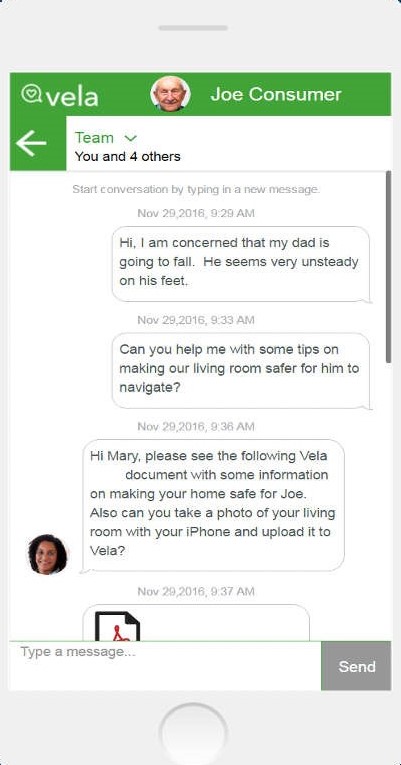
Former first lady Rosalynn Carter once said, “There are only four kinds of people in the world: Those who have been caregivers, those who are currently caregivers, those who will be caregivers, and those who will need caregivers.”
In 2020, Cigna conducted research to assess the impacts of caregiving on employees and employers.
The research came at the heels of COVID-19, which turned many employees into caregivers for the first time. The research shows that that about 30% of American adults care for a sick or disabled relative and 20% of these individuals are caregiving on top of their regular jobs. Women represent 65% to 70% of the people performing caregiver duties.
Additionally, our research found that Caregivers spend, on average, $7,000 on out-of-pocket expenses yearly, are at an increased risk of suffering from depression, and spend between 20 and 39 hours a week on caregiving.
“Caregiving can take an emotional and physical toll on people,” said Stacia Laffe-Nedvidek, LPCC, clinical operations director at Evernorth Behavioral Health, a Cigna company. “Our research has shown that caregivers are two times more likely to suffer from depression, and three-times more likely to have to take disability leave. They spend countless hours a week caregiving and for many this is on top of their full-time job.
“Many caregivers deal with high out of pocket expenses, which can cause a financial burden. And, stress, burnout, and feelings of being overwhelmed can often be described by caregivers as the perfect storm,” she said.
In celebration of National Family Caregivers month this November, we decided to deep dive into the type of care and support America’s caregivers need. Below we look at some of the ways we can help them live healthier, more fulfilled lives.
Self-Care Takes a Back Seat for Many Caregivers
According to Dr. Eric Huss, Psy.D, behavioral health total populations senior advisor at Evernorth, much of the void in the caregiving space is in providing support for those who are providing services. The No. 1 thing that Cigna hears from the caregiving community is the need for “spot care,” a.k.a. someone to help fill in when a caregiver needs to be away from the family member they are caring for.
Many of America’s caregivers, Dr. Huss said, are working full time, while raising their children, and caring for an elderly parent—leaving them with little time to spend on self-care. Research shows that caregivers are less likely to keep up with their own preventive care and are more likely to report sleep deprivation and poor eating habits. Many also report failure to exercise, get rest when sick, and make medical appointments for themselves.
“Think of someone who is living with an elderly parent who has trouble getting around,” Dr. Huss said. “For someone who doesn't have family or friends that can share in their caregiving responsibilities, being able to get a nursing assistant in the home, for example, is a great deal of support and frees them to concentrate on their own health and well-being.”

Finding Quality Eldercare
Do you need eldercare services? Or do you expect to need them in the future? Day care, short-term and long-term services and facilities are available. But sometimes they're not easy to find. Get the right resources and referrals.
How America’s Employers Can and Must Support Caregivers
According to Dr. Huss and Laffe-Nedvidek, employers have a role to play in supporting America’s caregivers. That’s because the aforementioned Cigna research found that the impacts of caregiving also cascade into the workplace and onto employers.
For example, employee caregivers have 8% higher total medical costs, are three times more likely to take short-term disability leave, and are 83% more likely to leave a job for better family benefits.
Giving these employees flexibility in how, when and where they get their work done is going to be key to keeping them healthy, happy and productive. Research has also found that a healthy workforce cultivates a more engaged and loyal customer base, and higher business profitability.
The impetus is on employers to give their people, and caregivers in particular, the capacity and the resources to practice self-care and prioritize their mental health. That could mean new benefits and programs like additional time-off for primary caregivers, or investing in health and well-being apps, as well as providing resources and access to mental health support.
“Employers will need to holistically address caregiver needs for absence management, productivity and health improvement,” Laffe-Nedvidek said.

Caregiver Programs that Connect and Support Whole-Person Health
Through a combination of behavioral, wellness, and pharmacy components, our comprehensive approach is designed to improve whole-person health – and your bottom line.
Digital Caregiver Resources and Support in Real-Time Throughout the Caregiving Journey
According to Laffe-Nedvidek, caregivers often struggle to find resources and get accurate information. Oftentimes just knowing where to start can be complicated. “Maneuvering through the system can be confusing, and knowing how to best advocate for your loved one can be overwhelming,” she said. The good news is that there are organizations working hard to make this information and access to resources available online. Good examples are AARP’s Caregiving Resource Center, the Caregiver Action Network, and the Family Caregiver Allegiance.

Caregiver Resources
Taking care of a loved one can be challenging. Explore these links to learn more about the resources available to help you.
Digital technology has completely reimagined how people connect to one another, and Dr. Huss believes it will play a crucial role in connecting caregivers to health professionals and coaches.
“The real-time aspect of digital,” he said, “has some big implications for streamlining how care is delivered, and how caregivers get the support they need.”
Dr. Huss provided Cigna's Caregiver HelpHub as an example of a digital resource that allows caregivers to connect with family, friends, and health professionals on care in real-time. The tool, which is powered by Seniorlink’s Vela, makes it easy for caregivers and health care professionals to reach one another in a way that is fast and secure to share up-to-date health information, receive support and deliver the best care possible. The Vela app is available to caregivers on both iPhone and Android devices.

"Caregivers deserve access to one-on-one coaching and personalized resources that help them plan for the future, avoid burnout, and make more confident decisions at every stage of caregiving,” Dr. Huss said.
Emotional Support is What Caregivers Need Most
It’s no secret that America’s caregivers need physical help to care for their loved ones, which includes help with daily tasks, decision-making, meals, transportation, cleaning, accommodations, and appointments—just to name a few. But they also need emotional support to deal with the stress of caring for a loved one.
Emotional support includes just lending an ear, but it could also be lending your time to help a caregiver. Even picking up a few items at the grocery store or fixing a meal can be helpful and relieve some of the strain. Additionally, caregivers need to speak up and ask for help. For those who don’t have the support system they need through family and friends, hiring someone to provide extra help could be an option, as could finding a grocery store and a pharmacy that delivers. Anything that takes items off of the caregiver’s to-do list is going to be helpful.
At Cigna, we offer a service called Caregiver Bridge, which provides caregivers with one-on-one coaches digitally and by phone, for extensive clinical support. Coaches help with stress management, chronic condition management, counseling, planning, resilience coaching, and more. Caregiver Bridge also offers caregivers emotional health support through Cigna's Digital Cognitive Behavioral Therapy program and quarterly educational seminars on caregiving topics.
The Future of Caregiving in America
According to Laffe-Nedvidek, a growing aging population is driving demand for more paid caregivers. Today, there are more than 46 million adults age 65 and older living in the U.S. That number is expected to grow to almost 90 million by 2050.
“We will see a rise in paid caregivers in the next few years, and the impetus is on the industry to ensure they get the training and resources they need to succeed and are compensated appropriately,” she said.
Dr. Huss, too, is optimistic about the future of caregiving, especially as employers begin to prioritize the caregivers in their workforces through personalized benefits and programs. “We are seeing a trend with employers, who are adding caregiving support as a key focus area,” Dr. Huss said. “This means more programs for caregivers from their employers, as well as more awareness of and access to the resources, services and tools that are out there to support them.”
To learn more about ways to support and empower America's caregivers, watch the video below: